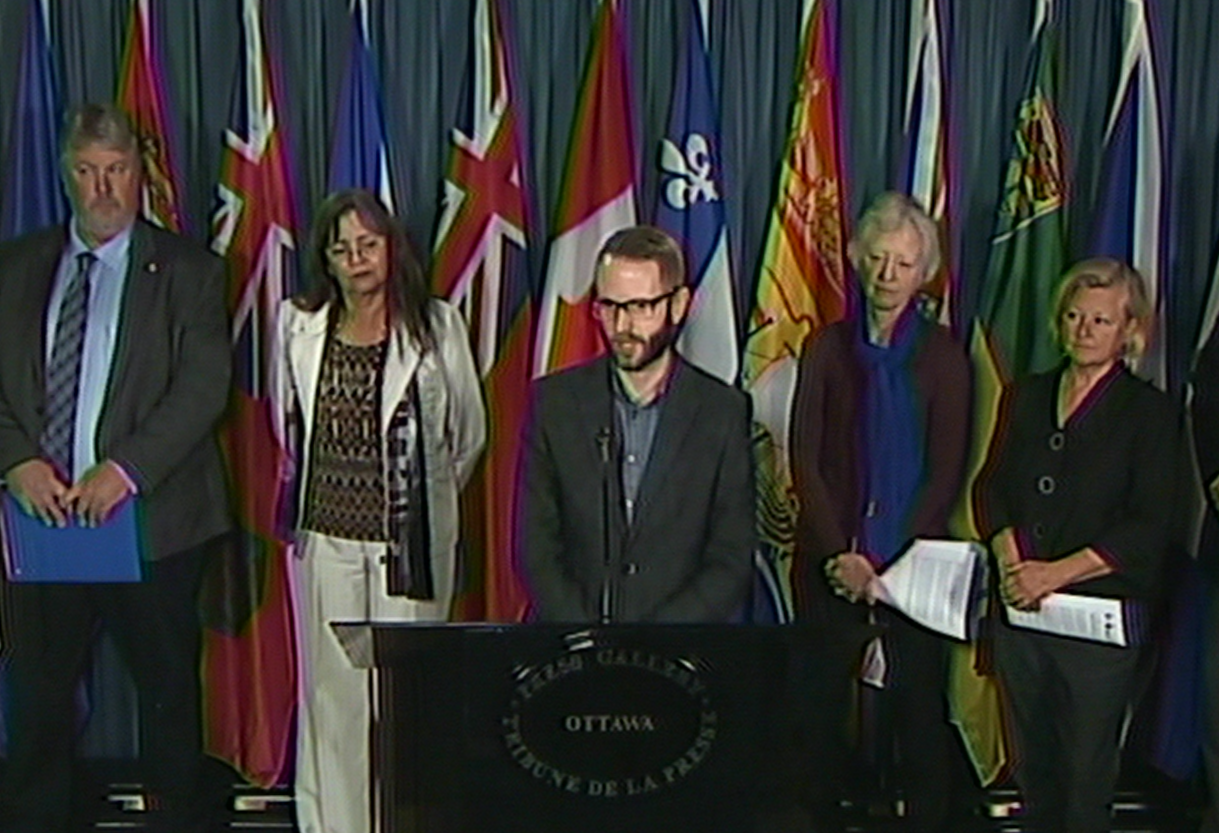
West Coast Environmental Law staff counsel Gavin Smith reflects on his meetings with Ministers to talk about the Pacific north coast oil tanker ban
While there are some great things I miss about Ottawa, the town that I called home during my time in law school, returning there this October to wet snow and frigid winds reminded me of a few things that I definitely do not miss. The reason that I was in Ottawa, shielding my face from the snow as I walked up Parliament Hill, was to join a delegation of First Nations, community groups, labour organizations and environmental groups to meet with Ministers regarding the promised federal oil tanker ban on the north coast of British Columbia.
The meetings took on particular urgency in light of the sinking of the Nathan E. Stewart in the territorial waters of the Heiltsuk Nation. The Nathan E. Stewart is the tug portion of an articulated tug and barge that transported petroleum products between Alaska and Washington state. The barge was fortunately empty at the time the Nathan E. Stewart sank, however the tug itself spilled over 100,000 litres of diesel and over 2,000 litres of industrial lubricants into the ocean, causing the closure of clam and crab fisheries in the area. Understandably, the incident has fixed a spotlight on the risks and impacts of petroleum spills on the coast.
Between October 26-28, our delegation met with Transport Minister Marc Garneau, Fisheries and Oceans Minister Dominic LeBlanc, and Natural Resources Minister Jim Carr, as well as the Chief of Staff to Environment and Climate Change Minister Catherine McKenna. Our delegation put forward a common message:
First, that the oil tanker ban should be formalized by an Act of Parliament. Second, that it should apply at minimum to all of the Hecate Strait, Dixon Entrance and Queen Charlotte Sound. Third, that it should be indefinite in duration. And finally that it should prohibit the bulk transport of all crude and refined oil products in tankers, while allowing for the continued supply of smaller amounts of essential fuels to coastal communities.
The meetings were largely positive. The Ministers were responsive and engaged with our delegation’s proposals for what the details of the oil tanker ban should look like. The Ministers told us to “stay tuned” because an announcement on the oil tanker moratorium would be “coming soon.” They did not divulge details on the federal government’s plans for the content of the oil tanker moratorium, citing Cabinet confidence. However, they did explicitly tell our delegation not to worry about the potential for a “fake moratorium”, emphasizing that a strong oil tanker moratorium on the north coast of B.C. is a promise that the Prime Minister is very committed to fulfilling.
Even in the two short weeks since our visit to Ottawa, a lot has happened: Minister LeBlanc, Minister Jody Wilson-Raybould and Minister Garneau have all travelled to the spill site in Heiltsuk territories; a second vessel, this time a sand and gravel barge, flipped and sank not far from the site of the Nathan E. Stewart incident; the Prime Minister announced an ocean protection plan; and, at the time of writing, the Nathan E. Stewart was about to be raised from the ocean floor.
Conspicuously absent in this flurry of news, however, is an announcement on an oil tanker ban, causing some observers to worry that the federal government’s commitment on this issue is weakening. On the other hand, Minister Garneau has repeated his promise that the oil tanker ban will be delivered before the end of 2016.
So, for supporters of an oil tanker ban on BC’s north coast, is it time to worry? My view is: withhold judgment for a couple weeks. We know that there will be a significant announcement on Enbridge’s Northern Gateway by November 25, likely a rejection of the project, and this will probably provide a clearer window into federal plans for a Pacific north coast oil tanker moratorium.
The federal government decided not to appeal the Federal Court of Appeal ruling that overturned Northern Gateway’s initial approval, and Cabinet set itself a deadline of November 25 to make a decision on whether to reject or approve the project. This timeline was not long enough to carry out the consultation with First Nations that the Federal Court of Appeal held would be necessary for an approval of the project. There was not enough time for proper consultation when that timeline was first set in late September, and there is certainly not enough time now that we are less than two weeks from the decision deadline and there has been no announcement of consultation with First Nations.
The reasonable conclusion to be drawn from these circumstances is that the federal Cabinet intends to reject Northern Gateway, because an approval would be sure to be overturned in another legal challenge, given the lack of consultation. The only other realistic federal decision would be a further extension of some sort, however our discussions during the Ministerial meetings indicated that a further extension for Northern Gateway is unlikely.
When the federal decision on Northern Gateway is announced within the next couple weeks, will the public have questions about the Pacific north coast oil tanker ban, which is tightly linked with opposition to Northern Gateway? Certainly. Will the federal government want to continue dodging those oil tanker ban questions as it announces its decision on Northern Gateway? Probably not. In my view, the federal government will likely be ready to reveal information about its plans for a Pacific north coast oil tanker moratorium before or by the time it makes its announcement on Northern Gateway within the next two weeks.
We’ll be watching closely.
By Gavin Smith, Staff Counsel